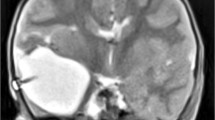Abstract
Purpose
A low radiation burden is essential during diagnostic procedures in pediatric patients due to their high tissue sensitivity. Using MR examination instead of the routinely used CT reduces the radiation exposure and the risk of adverse stochastic effects. Our retrospective study evaluated the possibility of using ultrafast single-shot (SSh) sequences and turbo spin echo (TSE) sequences in rapid MR brain imaging in pediatric patients with hydrocephalus and a programmable ventriculoperitoneal drainage system.
Methods
SSh sequences seem to be suitable for examining pediatric patients due to the speed of using this technique, but significant susceptibility artifacts due to the programmable drainage valve degrade the image quality. Therefore, a rapid MR examination protocol based on TSE sequences, less sensitive to artifacts due to ferromagnetic components, has been developed. Of 61 pediatric patients who were examined using MR and the SSh sequence protocol, a group of 15 patients with hydrocephalus and a programmable drainage system also underwent TSE sequence MR imaging. The susceptibility artifact volume in both rapid MR protocols was evaluated using a semiautomatic volumetry system.
Results
A statistically significant decrease in the susceptibility artifact volume has been demonstrated in TSE sequence imaging in comparison with SSh sequences. Using TSE sequences reduced the influence of artifacts from the programmable valve, and the image quality in all cases was rated as excellent. In all patients, rapid MR examinations were performed without any need for intravenous sedation or general anesthesia.
Conclusions
Our study results strongly suggest the superiority of the TSE sequence MR protocol compared to the SSh sequence protocol in pediatric patients with a programmable ventriculoperitoneal drainage system due to a significant reduction of susceptibility artifact volume. Both rapid sequence MR protocols provide quick and satisfactory brain imaging with no ionizing radiation and a reduced need for intravenous or general anesthesia.







Similar content being viewed by others
References
Kim I, Torrey SB, Milla SS, Torch MC, Tunik MG, Foltin JC (2015) Benefits of brain magnetic resonance imaging over computed tomography in children requiring emergency evaluation of ventriculoperitoneal shunt malfunction: reducing lifetime attributable risk of cancer. Pediatr Emerg Care 31:239–242
O'Neill BR, Pruthi S, Bains H, Robison R, Weir K, Ojemann J, Ellenbogen R, Avellino A, Browd SR (2013) Rapid sequence magnetic resonance imaging in the assessment of children with hydrocephalus. World Neurosurg 80:e307–e312
Sellin JN, Cherian J, Barry JM, Ryan SL, Luerssen TG, Jea A (2014) Utility of computed tomography or magnetic resonance imaging evaluation of ventricular morphology in suspected cerebrospinal fluid shunt malfunction. J Neurosurg Pediatr 14:160–166
Singleton LM (2016) Rapid brain magnetic resonance imaging: an alternative to head computed tomography for evaluation of ventricular shunt malfunction. J Pediatr 171:320
Yue EL, Meckler GD, Fleischman RJ, Selden NR, Bardo DM, Chu O'Connor AK, Vu ET, Fu R, Spiro DM (2015) Test characteristics of quick brain MRI for shunt evaluation in children: an alternative modality to avoid radiation. J Neurosurg Pediatr 15:420–426
Gotte MJ, Russel IK, de Roest GJ, Germans T, Veldkamp RF, Knaapen P, Allaart CP, van Rossum AC (2010) Magnetic resonance imaging, pacemakers and implantable cardioverter-defibrillators: current situation and clinical perspective. Neth Heart J 18:31–37
Lollis SS, Mamourian AC, Vaccaro TJ, Duhaime AC (2010) Programmable CSF shunt valves: radiographic identification and interpretation. AJNR Am J Neuroradiol 31:1343–1346
Stradiotti P, Curti A, Castellazzi G, Zerbi A (2009) Metal-related artifacts in instrumented spine. Techniques for reducing artifacts in CT and MRI: state of the art. Eur Spine J 18(Suppl 1):102–108
Naidich TPCM, Soonmee CH, Smirniotopoulos JG (2013) Imaging of the brain. Elsevier Saunders, Philadelphia
Author information
Authors and Affiliations
Corresponding author
Ethics declarations
Conflict of interest
The authors hereby declare they have no actual or potential conflicts of interest with direct or potential influence on the presented work.
Rights and permissions
About this article
Cite this article
Brichtová, E., Šenkyřík, J. SSh versus TSE sequence protocol in rapid MR examination of pediatric patients with programmable drainage system. Childs Nerv Syst 33, 753–758 (2017). https://doi.org/10.1007/s00381-017-3385-2
Received:
Accepted:
Published:
Issue Date:
DOI: https://doi.org/10.1007/s00381-017-3385-2




